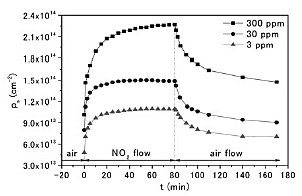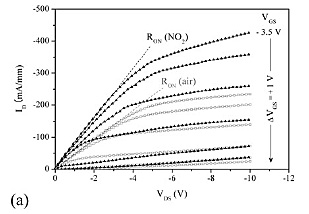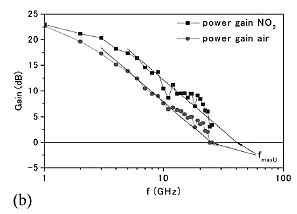Materials Science Laboratory
Diamond transistors are expected to provide the best performance among
semiconductors in high-frequency high-power operation because diamond has
very high carrier velocity, the highest breakdown electric field strength,
and the highest thermal conductivity. We reported the highest cut-off frequencies
of fT of 45 GHz, fmax of 120 GHz, and the highest RF output power density of 2.1 W/mm at 1 GHz [1]. However, the p-type doping mechanism of the hydrogen termination used in diamond transistors has not been clarified and the hole concentration has been limited at 1×1013 cm-2.
We have experimentally clarified that nitrogen dioxide (NO2) is the most beneficial p-type dopant for H-terminated diamond [2-4].
As shown in Fig. 1, when NO2 gas is adsorbed onto H-terminated diamond, the hole concentration increased
greatly. With 300 ppm NO2, the maximum hole concentration reached 2.3×1014 cm-2, a value that is 20 times higher than the reported value in air. With this technology, we fabricated H-terminated diamond FETs whose drain current is 1.8 times higher due to a decrease in source resistance [Fig. 2(a)] and whose power-gain cut-off frequency (fmaxU) is 1.5 times higher [Fig. 2(b)] than those in air [2].
This work was partly supported by the SCOPE project of the Ministry of
Internal Affairs and Communications, Japan.
[1] M. Kasu, K. Ueda, Y. Yamauchi et al., Diamond Relat. Mater. 16 (2007) 1010.
[2] M. Kubovic and M. Kasu, Appl. Phys. Express 2 (2009) 086502.
[3] M. Kubovic, M. Kasu, and H. Kageshima, Appl. Phys. Lett. 96 (2010) 052101.
[4] M. Kubovic, M. Kasu, H. Kageshima, and F. Maeda, Diamond Relat. Mater. (in press).
 |
||
|
||
  |
||
|